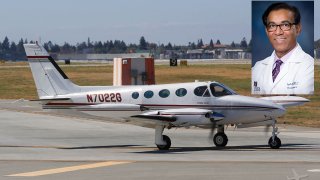
It will likely be weeks or maybe even months before Santee residents know what happened Monday in the skies over that East County city, but a look at official records and a discussion with a local flight instructor may offer some clues into the cause of the fatal crash.
For that matter, it will be some time before there is official confirmation about who was killed in the plane piloted by Dr. Saguta Das. On Tuesday, county public information officer Chuck Westerheide told NBC 7 that official IDs will likely not come out for a few weeks.
However, discussions with a local flight instructor, Chris Sluka, examinations of Federal Aviation Administration records and a review of communications between Das and local air traffic controllers offer a picture of what was happening shortly after noon on Monday above Santee.
Get San Diego local news, weather forecasts, sports and lifestyle stories to your inbox. Sign up for NBC San Diego newsletters.
Das, a San Diego County resident of the Fairbanks Ranch community, had filed flight plans for Montgomery Field in Kearny Mesa, returning from a trip to Yuma, Arizona, a flight he made regularly while traveling for his work as a physician affiliated with the Yuma Regional Medical Center.
FAA records show that Das' flight experience and pilot training were well above average. In fact, he earned a commercial pilot certificate in October 2014, which would have allowed him to carry paying passengers. Specifically, he had an airplane multI engine rating and instrument airplane certificate, something most private pilots don't possess. The certification allowed Das to fly more types of planes with fewer restrictions. In the simplest of terms, an instrument rating means the pilot can fly a plane without seeing outside the window — or at night — relying instead solely on the plane's instruments.
Local
Furthermore, Das appears to have a lot of flight experience. Since July 19, his twin-engine Cessna C340 made 25 flights, most of them between San Diego and Yuma, but he also took it up for some longer, three-hour flights as well.
San Diego flight instructor Christopher Sluka, who did not know Das personally, told NBC 7 that, based on Das' flight history, he wasn’t a typical weekend warrior, or even someone with a flying hobby. He believes that Das got around and definitely knew what he was doing.
Also, Das received a first class medical certification in August 2020, the most difficult medical-class certification, one that is expensive to obtain. In fact, only airline pilots are required to have that certificate, which means, as of last summer, he passed the most rigorous medical examination. Pilots over the age of 40 are all required need to pass an EKG test, something Das, a cardiologist, would have been well-versed about.
Sluka told NBC 7 that the average speed of descent is 500 feet per minute. At the time of the crash, Das is believed to have been flying at 3,800 ft per minute.
Sluka believes that fact, combined with an audio recording of Das' communication with air traffic controllers, makes Sluka suspect Das was disoriented and believed he was ascending when he was, in fact, descending, until he got out of the clouds, when it was too late to correct his trajectory.
In an audio recording of Das' exchanges with air traffic control, a controller can be heard telling Das his plane was too low and instructing Das to climb to 4,000 feet, and then Das confirming receipt of the instructions.
“Low altitude alert, climb immediately, climb the airplane,” the controller told Das.
However, the controller did not see an adjustment made and repeatedly urged Das to climb to 5,000 feet. When the aircraft remained at 1,500 feet, the controller warned: “You appear to be descending again, sir.”
Sluka believes the reason for the crash was either disorientation or that Das had suffered a medical incident.
Either way, Sluka said, “the plane wasn’t falling out of the sky, it was flying,” Sluka said.
Al Diehl, a former National Transportation Safety Board investigator, said the recording between air traffic control and Das indicates he was trying to deal with a major distraction or significant emergency on his own, breaking a basic rule that aviators should always tell controllers everything.
“The first thing you do when you’re in trouble is call, climb and confess — and he did not do any of the three," Diehl said. “These are very basic rules that flight instructors tell their students.”
Diehl, who helped design a Cessna cockpit, said the twin-engine aircraft has a complex system that could lead to deadly mistakes.
Clouds and windy weather may have complicated Das' ability to handle the aircraft, Diehl said.
Das and another man, Steve Krueger, a local UPS delivery driver, were killed at the scene, and two other people were hurt as well. A pair of homes were destroyed and five others were damaged.
On Tuesday, three investigators from the National Transportation Safety Board (NTSB) arrived in Santee to look into the deadly crash.
NTSB officials will be assessing the scene of the crash, gathering as much information as possible to determine what caused the tragedy.
"Part of the investigation will be to request radar data, weather information, air traffic control communication, airplane maintenance records and the pilot’s medical records," a spokesperson for the agency said in a statement. "NTSB investigators will look at the human, machine and environment as the outline of the investigation."
The NTSB spokesperson said a preliminary report on the investigators' findings is expected to publish Oct. 26 -- 15 days after the crash.
The Associated Press contributed to this report -- Ed.



